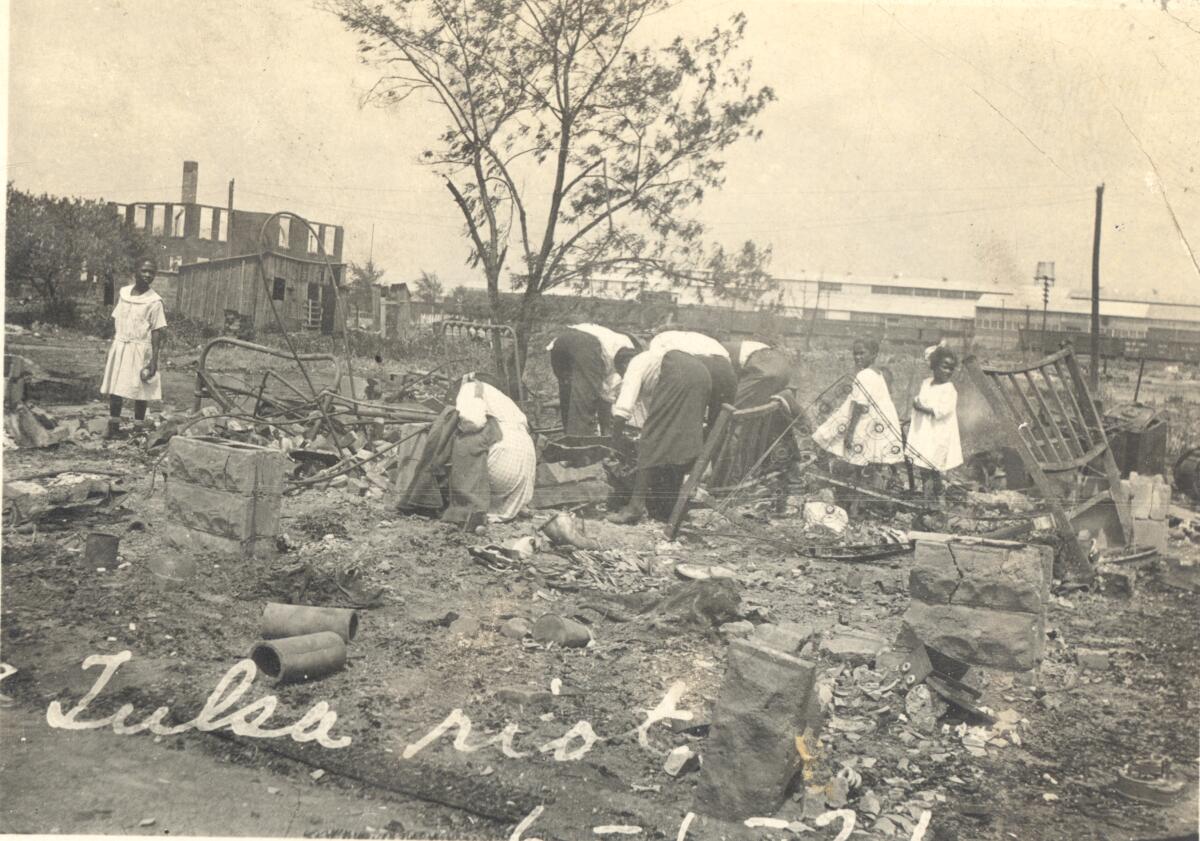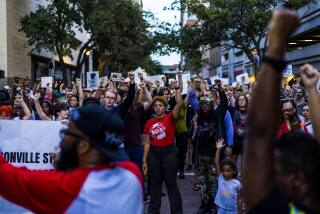Editorial: A century after the Tulsa massacre, we have yet to atone for Americaâs racism

If you look at the long history of white violence against Black and other nonwhite people in the United States, the rampage through the Greenwood district of Tulsa, Okla., 100 years ago today stands out for its brutality. A chance encounter between a young Black man and a young white woman operating the elevator in a four-story building led to a charge of rape; as rumors whirled and a local newspaper fanned passions, a confrontation outside the courthouse spiraled within hours into a mass attack by a white mob on the segregated Black community.
More than 300 people, nearly all of them Black, were killed as the mob looted and burned 35 square blocks of mostly Black-owned homes and businesses â Black Wall Street, it was called. Incredibly, some 5,000 Black people also were rounded up and held en masse at an outdoor sports field in âprotectiveâ detention for weeks, many not being released unless a white Tulsan vouched for them.
The scope of the violence, the damage and the deaths in Tulsa stand as a singular moment of national embarrassment, of a radically extreme display of white supremacy. But in truth it was just one of countless spasms of hate. It is of a piece with our founding practice of race-based slavery; with the 1863 riots (most infamously in New York City) in which newly draft-eligible white men rampaged through Black communities; with thousands of lynchings that were, in effect, mob attacks by white perpetrators against individual Black victims â Tulsa writ small; and with the ongoing deplorable levels of police killing often-unarmed Black Americans such as George Floyd just over a year ago.
Because slavery drove the young United Statesâ economy â from the cotton and other farm fields of the Deep South to the Wall Street firms and other banks that financed them to the New England textile mills that bought the cotton to the seagoing merchants on the East Coast who trafficked in human chattel â our most overt displays of white supremacy historically have targeted Africans and African descendants.
The Times Editorial Board examines the reckoning of the last year and considers what it means for policing and protest in Los Angeles and elsewhere.
And it hasnât just been violence for violenceâs sake. It was to send a clear and brutal message: Stay in your place, donât aspire, donât think you are the equal of white people. It was, in fact, white society saying: âWe not only donât see you as equals, but we wonât let you build anything of your own, either. You canât have a Black Wall Street. You canât have intergenerational wealth. That is reserved for us.â
Of course, Black Americans are by no means the nationâs only victims of white violence. Here in Los Angeles, a white mob descended on Chinatown in 1871 after a shootout between two rival Chinese groups that killed a white saloon owner and wounded a police officer; the mob lynched 18 Chinese people, only one of whom may have been involved in the original gunfight.
Countless Native Americans were slaughtered in sporadic massacres, often by U.S. soldiers, during the westward expansion under Manifest Destiny, a conceit framed by the notion that white America was superior to the Native people and thus divinely endowed to control the continent. That contributed to the deaths of thousands of Indigenous people in California during an extended campaign around the time of statehood to rid the region of them â a genocide.
Thereâs too much history here to ignore, and too many atrocities to single out which groups of victims suffered the most. Black people were enslaved by the hundreds of thousands; so, to a lesser extent, were Indigenous people and Latinos. All felt the sting of white supremacy, of white rage, of white people committing violence with impunity and, at times, as an extension of government policy forged, needless to say, by white political leaders elected primarily by white men from the nationâs formation through the early 20th century.
Itâs telling that no one can say with certainty how many Black Americans died in 1898 when white people staged a coup in Wilmington, N.C., to end a racially integrated city government (burning down a Black newspaper office in the bargain), and in 1923 when a white mob destroyed the Black Florida village of Rosewood. The killers didnât bother to keep track of the killed, although the total was easily in the dozens. And these episodes reverberate not because they were outliers but because they were part of a historical pattern.
We canât separate these spasms of violence from our often racially framed criminal justice system or our social practice â even though we have declared it illegal â of physical, educational and economic segregation. As a nation we must confront and reckon with that past and its contemporary effects.
White Americans in particular need to move beyond the rationalization that white people today did not kill Black people a century ago. Of course they didnât. But todayâs white Americans benefit from that legacy of racism in a society in which Black Americans have less access to healthcare, face more hurdles in accumulating wealth and accessing capital, often are educated in de facto segregated schools, and face harsher police scrutiny and more severe criminal penalties.
On the 100th anniversary of that murderous attack in Tulsa, itâs important to reflect on the past, of course, and to remember the victims. Perhaps more important, though, we should not think of Tulsa â and Rosewood and Wilmington and all the other violent expressions of white supremacy â as relics of bygone eras and beliefs.
Racism still lives with us. It may not manifest itself as a mob descending on and slaughtering a Black community, or in the lynching of residents of Chinatown, or in the genocide of Native Americans. But it is still here. We must confront it, defuse it and dismantle its living legacy.
This is the seventh and final editorial in a series.
More to Read
A cure for the common opinion
Get thought-provoking perspectives with our weekly newsletter.
You may occasionally receive promotional content from the Los Angeles Times.











